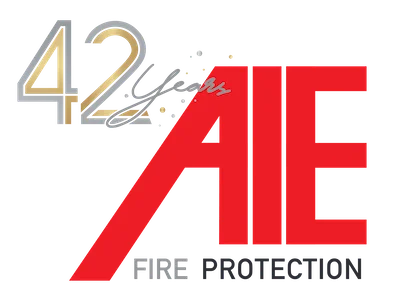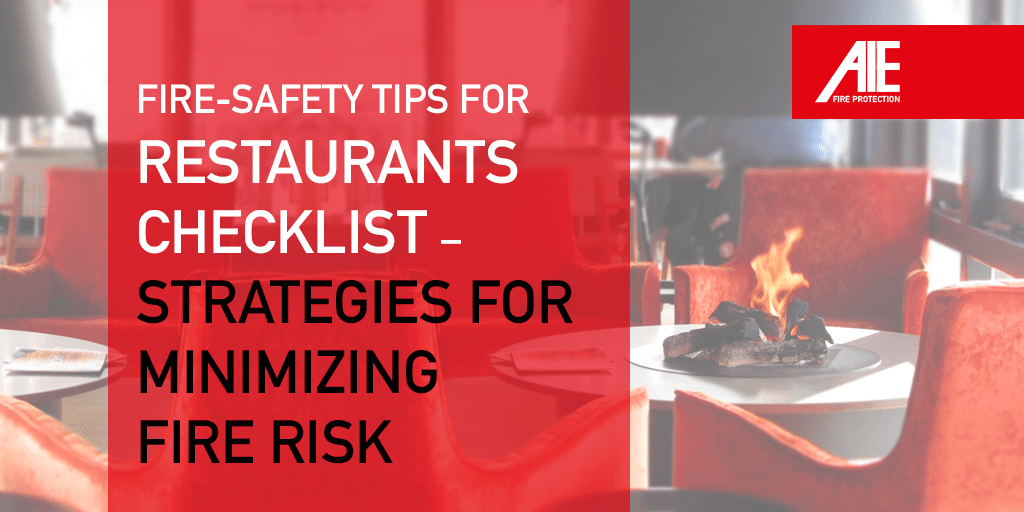When it comes to fire prevention and fire safety in restaurants, there are several regular activities you can do on a daily or weekly basis to reduce fire risk. If you don’t have a restaurant safety plan, combine these simple, affordable fire safety norms for restaurants to create one! A commercial kitchen fire safety plan ensures restaurant fire safety procedures are followed and your business is safe.
Taking fire prevention seriously with a restaurant safety checklist keeps your customers, employees, and business safe, provides peace of mind, lowers insurance costs, and ensures your equipment stays in good running order. If you don’t have written fire safety protocol, create a restaurant fire safety plan that includes a daily fire safety checklist, as well as routine inspections and maintenance.
At AIE, we want to make it as easy as possible for you to start lowering your fire risk today, so we’ve compiled the Top 5 Restaurant Fire-Safety Tips to include in your plan.
- Use your restaurant kitchen safety checklist daily.
- Inspect fire extinguishers every month.
- Clean kitchen hoods frequently.
- Ensure regular fire safety training for staff.
- Keep up with fire sprinkler inspections and maintenance.
Hang this restaurant fire safety checklist somewhere your staff can easily read to ensure these vital tasks are understood and completed. Utilizing this checklist can save lives, money, and time.
A Restaurant Safety Checklist Ensures Fire Safety in Restaurants
Restaurant fire safety should be a daily priority. Use these restaurant safety tips and strategies to create your business’s fire safety plan.
#1 – Daily Fire Safety Checklist: Incorporate it into Your Routine
The best thing you can do to minimize fire risk is to make fire prevention part of your daily routine with a daily fire safety checklist. To ensure restaurant fire safety is a daily priority, include the below items as part of your daily tasks.
- Keep the kitchen and all other areas debris-free.
- Stop trash from overflowing and put it in the dumpster as needed rather than just near the door. This opens doorways and evacuation paths in case of emergency and stops paper and other flammables from coming into contact with commercial kitchen equipment, such as stoves, ovens, grills, the furnace or air conditioner, refrigeration equipment, electric appliances, overheated motors, machinery belts, and open flames.
- Maintain clean, uncluttered work areas keeps the fire load to a minimum.
Incorporating these fire safety norms for restaurants into your restaurant kitchen safety checklist can avoid accidents, ensure safety, and save lives and money.
#2 – Monthly Commercial Fire Extinguisher Inspections
Portable fire extinguishers and their maintenance are crucial to include in your restaurant safety checklist or fire safety plan. You must follow nfpa fire extinguisher inspection requirements and have visual fire extinguisher inspections every 30 days. It seems obvious, but if you need an extinguisher and can’t find one or it doesn’t work, your entire restaurant could go up in flames. Here are the main questions to ask yourself about your restaurant fire safety and kitchen fire extinguishers to ensure you’re prepared:
#3 – Frequent Kitchen Hood Inspections & Cleaning
We get asked regularly, “How often should I inspect and clean my kitchen hood system and how will I know it’s time?” The answer depends on the volume of food and type of food you’re cooking.
NFPA-96 requires kitchen hood inspections two times per year by a certified professional. However, at AIE we feel kitchen hood cleaning twice a year is not nearly enough to lower fire risk. If you’re a high-volume restaurant or a quick-service restaurant (QSR), the kitchen hood will get dirty faster than a small, lower-volume restaurant or a restaurant that does minimal frying.
Frequent Kitchen Hood Cleaning
To reduce facility fire risks, clean the hood filter frequently – weekly, monthly, or bi-monthly. Add this cleaning to your restaurant safety checklist to ensure it’s done regularly. Cleaning this equipment is one of the most impactful restaurant safety tips.
If you’re high-volume, make it part of the daily checklist and cleaning routine. This stops the build-up of grease and debris on the filter and helps keep it from accumulating in the flue. This simple task can decrease the likelihood of hood fires and keep your kitchen running safely. Regular kitchen hood cleaning is an important part of a fire prevention plan and fire safety in restaurants.
#4 – Kitchen Employee Training on Proper Use of Equipment
It is easy to put your restaurant’s fire safety plan and training on the back burner when you’re running a busy bar, eatery, and/or commercial kitchen. But, with nearly 21 bar and restaurant fires reported daily in the U.S., of which 61% are caused by cooking equipment (NFPA), it is crucial to take kitchen equipment and fire safety training seriously.
Use these restaurant-specific tips when addressing training in your commercial kitchen fire safety plan:
Only with proper restaurant employee training and adherence to NFPA and OSHA fire-safety standards can you minimize risks and provide the best fire safety in restaurants. Prioritize customer and staff safety with routine training and a restaurant employee training checklist
#5 – Inspect & Maintain Your Fire Sprinkler System
Though not every restaurant is required by law to have a fire sprinkler system, if you do, it is no use having one unless you regularly inspect and maintain it. Depending on the type of system you have and your hazard classification, quarterly and annual safety inspections are mandated by NFPA code and must be performed by a state-licensed technician. If you need repairs or maintenance, it is best to use an experienced, certified technician with a satisfaction guarantee. Be sure to include routine inspections in your restaurant safety plan.
Also, did you know, a licensed sprinkler inspector can legally inspect your backflow preventers, but a backflow inspector cannot, by code, inspect your sprinkler system? One of the most common mistakes we see in the restaurant industry is that one person is paid to inspect backflow preventers and another for sprinkler systems. Save time and expenses by using one source, like AIE, who can conduct sprinkler system inspections, regularly inspect your backflow preventers, represent you during planned safety inspections, and send experienced technicians to make any repairs and service your equipment. We are experts at fire code in restaurants.
Minimize Liability with a Restaurant Fire Safety Plan & Daily Checklist
Keep your restaurant, staff, customers, and kitchen safe with fire-safety strategies tied to your daily routine. Ensure your staff is trained on the restaurant fire safety checklist, weekly fire safety to-dos & overall safety protocol. Declutter floors, doorways, and evacuation pathways and prioritize cleanliness, especially of kitchen equipment. Regularly inspect and maintain your fire extinguishers, sprinkler system, and kitchen hood and implement regular fire-safety and kitchen equipment training.
These fire safety norms are important measures for preventing fire events and working safe. Work with your team to get in the habit of working through your daily fire safety checklist. Ensure your staff is aware of how to practice fire safety in restaurants by displaying your restaurant safety checklist in a highly trafficked area.
Fire risk is everywhere in restaurants and the food industry, so fire safety codes for restaurants should be at the forefront of your business. These 5 kitchen fire safety tips are easy and cost-effective to implement, yet vital to the well-being of customers and staff.
When fire safety norms for restaurants and training employees are taken seriously, you minimize the risks and can stop the smallest fire before it escalates. Get the peace of mind you deserve knowing your business is code-compliant and fire-safe every day, not just when the fire marshal shows up.
If you have any questions about this article or would like one nationwide source for all your fire-safety needs, contact AIE today or call 800-892-9863
Information posted in our blog is merely for educational and informational purposes. While the information has been verified to the best of our abilities, we cannot guarantee its total accuracy, and it should not be considered legally binding advice. This blog is not intended as a substitute for professional advice, and should you decide to act upon the information, you do so at your own risk.


Recent Comments